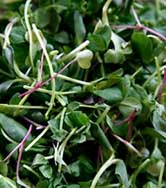Three Sisters Garden
- By Heidi Lewis
- Reading Time: 3 mins.
Farmers Tracey Vowell and Kathe Roybal came to farming after careers in the restaurant world. Tracey was managing chef at Frontera, a Rick Bayless restaurant in downtown Chicago, where she helped shape the cuisine and find local sources for produce, including her garden. But after 18 years inside of kitchens, she and Kathe decided to get out into the sunshine and begin a farming venture that brings new significance to the restaurant expression “in the weeds.”
 “Having been exposed to many different farmers in the course of our restaurant careers, we had the opportunity to make observations about the differences in their lives and ours, and we were very interested in what we saw. We started working toward gaining the knowledge and expertise that would eventually help us make a decision about what kind of farming we wanted to do and give us the confidence to buy a piece of land and get started,” they told Chicago Green City Market.
“Having been exposed to many different farmers in the course of our restaurant careers, we had the opportunity to make observations about the differences in their lives and ours, and we were very interested in what we saw. We started working toward gaining the knowledge and expertise that would eventually help us make a decision about what kind of farming we wanted to do and give us the confidence to buy a piece of land and get started,” they told Chicago Green City Market.
Tracey and Kathe purchased their nine-acre farm in Kankakee, IL, in 2000 and named it Three Sisters Garden after the Native American sustainable agriculture technique of intercropping corn, beans, and squash. The corn provides a stalk for the beans to climb, the beans feed nitrogen into the soil, and the squash shades the ground and prevents weeds. Tracey and Kathe’s farming and business methods convey this sustainable philosophy – folding together the goals of healthy land and tasty food on an achievable economic scale.
Want farm-fresh fruit?
We've got you covered.
Their Certified Naturally Grown northern Illinois parcel is cradled between a meandering bend of the Kankakee (kang-ka-KEY) River and a buffer of trees. “It’s flatter than a fritter,” says Tracey. On one quadrant where the land tends to flood, they grow alfalfa and rye hay. They don’t have horses, but the hay distracts the encroaching deer that would normally raid the vegetable fields; additionally, they sell the higher value hay for lesser value straw, which they use for mulch.

The other straw-into-gold crop they’re quite well-known for is huitlacoche (weet-la-COH-cheh), a fungus that is as prized to the Mexican people as the truffle is to the French. Elsewhere, huitlacoche is known as “corn smut” and is considered a blight. Tracey sought out a premier corn scientist whose assignment had been to eradicate the fungus so they could learn how to grow and perfect this delicacy for Chicago chefs. As Hoosier playwright George Ade said, “One man’s poison ivy is another man’s spinach.”
 What also sets these women apart from traditional one-season Midwestern farmers in their area is their eye for a year-round table. In the fall they have a loyal following for their popcorn; in the winter, they use greenhouses and hoop houses to grow microgreens for restaurants, and they grind corn, roll oats, and dry beans, which takes them into the early spring crops; in summer it’s cukes and zukes. What to look forward to? Their sweet corn. “It’s to die for,” says Tracey. And when the former chef from Frontera recommends the corn—you might wanna make a reservation.
What also sets these women apart from traditional one-season Midwestern farmers in their area is their eye for a year-round table. In the fall they have a loyal following for their popcorn; in the winter, they use greenhouses and hoop houses to grow microgreens for restaurants, and they grind corn, roll oats, and dry beans, which takes them into the early spring crops; in summer it’s cukes and zukes. What to look forward to? Their sweet corn. “It’s to die for,” says Tracey. And when the former chef from Frontera recommends the corn—you might wanna make a reservation.
Want farm-fresh fruit?
We've got you covered.
Heidi Lewis writes about farms, bees, and fruit from her home in Sonoma County, CA. She’s been with The FruitGuys since they were FruitKids.


